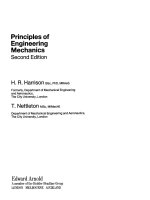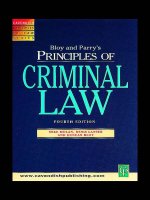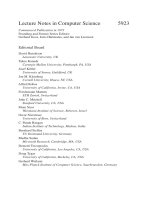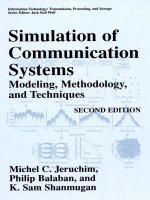Principles of communication systems 6th edition
Bạn đang xem bản rút gọn của tài liệu. Xem và tải ngay bản đầy đủ của tài liệu tại đây (3.71 MB, 230 trang )
Introduction
Signal Retrieval and Communication
Theory of systems for the conveyance of
information
Characteristics of communication systems
Uncertainty
Keep in mind: Signal retrieval problem
Noise and “information” (deterministic vs probabilistic)
Communication (only particular type of signal retrieval
problem)
Usually two resources to consider
Bandwidth vs. Power
2
Innovation in microelectronics and
signal processing have led to the
proliferation of communication systems
3
Block Diagram of a Communication
System
Keep in mind that this is only a model!
Can we make it simpler? More
complicated? Consequences?
4
Components of Block Diagram
Input transducer
Messages
Message conversion
Analog or digital
E.g. speech voltage variations
Transmitter
Couple the message to the channel
Modulation, filtering, amplification, and coupling
Modulation
For the ease of radiation
To reduce noise and interference
For channel assignment
For multiplexing or transmission of several messages over a single channel
To overcome equipment limitations
5
Channel Characteristics
Channel
Signal degradation (convolutive noise)
Additive “noise”
Receiver
Sensor noise, thermal noise, interference (e.g. MUI, jammer,
…)
Demodulation, amplification
Output transducer
Loudspeaker, tape recorder, PCs, CRT, LCD, etc.
6
Channel Characteristics
Additive noise sources (usu. less troublesome)
Internal noise
Noise generated by components within a communication system,
such as resistors and solid-state active devices
Thermal noise
Shot noise
Random motion of free electrons in conductor or semiconductor excited
by thermal excitation
Random arrival of discrete charge carriers in thermionic tubes or
semiconductor junction devices
Flicker noise
Produced in semiconductors by a mechanism not well understood and is
more severe in lower frequency
7
Channel Characteristics
External noise
Noise generated from sources outside a communication
system, including atmospheric, man-made, and extraterrestrial
sources
Atmospheric noise
Impulsive in nature, i.e. large amplitude, short-duration bursts
(how should we model it? Why model it?)
Man-made noise
Impulsive
Automobile and aircraft ignition noise, radio-frequency
interference (RFI), e.g. MUI
Extraterrestrial noise
Solar and cosmic noise
8
Channel Characteristics
Convolutive noise (usu. very troublesome)
Multiple transmission paths
Diffuse type
Specular type
One or two strong reflected rays
Fading
Numerous reflected components
Random changes in attenuation within the transmission
medium
How do we model it? Why do we care?
9
10
802.11a/b/g
802.11n/ac
802.11ad
11
Traditional Cellular Network
Characteristics
•
Large frequency reuse
factor
•
Performance enhanced
by increasing spectrum
efficiency
Major Issues
•
Low system capacity
•
Poor performance for
cell edge users
MBS
MBS
MBS
MBS
MBS
MBS
MBS
MBS
MBS
12
B4G Objectives
Spectrum
Efficiency
×
Spectrum
Extension
/Utilization
×
=
Network
Density
Required capacity
2
(bps/km = bps/Hz/cell × Hz × cell/km2)
1000x
Capacity
Traffic offloading
(alternative means for communications)
Non-orthogonal multiple access
controller
Massive MIMO, advanced
receiver
Spectrum efficiency
WiFi offload, D2D, etc.
Dense urban
Shopping mall
Home/office
Current
capacity
Cellular network assists
local area radio access
Spectrum extension
Multiple access
technologies with Tx-Rx
cooperative interference
cancellation
New cellular concept for cost/energy
efficient dense deployment
Existing cellular bands
Very wide
Super wide
frequency
Hybrid access using coverage and
capacity spectrum bands
13
In a Nutshell…
Femto-BS
D2D
Relay
Characteristics
•
Wireless backhaul
•
Open access
•
Operator-deployed
Major Issues
•
Effective backhaul
design
•
Mitigating relay to
macrocell
interference
Characteristics
•
Wired backhaul
•
User-deployed
•
Closed/open/hybrid
access
Major Issues
•
Femto-to-femto
interference and
femto-to-macro
interference
Characteristics
•
Resource reuse
•
Operatorassisted
Major Issues
•
Neighbor
discovery
•
Offloading
traffic
D2D
backhaul
Relay
MBS
Femto-BS
Pico-BS
Macrocells: 20-40 watts
(large footprint)
Pico-BS
Characteristics
•
Wired backhaul
•
Operator-deployed
•
Open access
Major Issues
•
Offloading traffic from macro to picocells
•
Mitigate interference
14
Systems Analysis Techniques
Time and frequency domain analyses
Looking at things from different perspective
Modulation and communication theories
Modulation theory employs time and frequency domain
analyses to analyze and design systems for modulating
and demodulating of information-bearing signals
Analysis of interfering signals on system performance,
and design of systems to counteract their effects are
part of communication theory, which makes use of
modulation theory
15
Probabilistic Approaches to System
Optimization
As seen earlier, proper modeling of (additive and
convolutive) noise (incl. interference) is important
Probabilistic models are often used
Why?
Design
Optimal design is crucial
Many “optimal” design are not optimal – depends on perspective
How do we do it? (We are engineers, this is important!)
Statistical signal detection and estimation theory
Wiener optimum filter, matched filter, adaptive filter, and many more…
Information theory and coding
Shannon says it can be done, but didn’t tell us how it can be done
16
Signal and Linear System
Analysis
Signal Model and Classifications
Deterministic signals
Completely specified function of time: predictable, no
uncertainty. E.g.
=
x ( t ) A cos ω0t , − ∞ < t < ∞,
where A and ω0 are constants
Random/Stochastic signals
Take on random values at any given time instant and
characterized by pdf: not completely predictable, with
uncertainty. E.g. x(n) = value of a die shown when tossed at time
index n
If the signal is random, how do we describe (model) it?
2
Signal Model and Classifications
Periodic signal
A signal x(t) is periodic iff there exists a constant T0,
such that x(t + T0) = x(t), ∀t. The smallest such T0 is
called fundamental period or simply period
Aperiodic signal
Cannot find a finite T0 such that x(t + T0) = x(t), ∀t
3
Signal Model and Classifications
Phasor signal and spectra
A special periodic function
j (ω0t +θ )
=
x ( t ) Ae
=
Ae jθ e jω0t ,
x ( t ) rotating phasor, Ae jθ phasor, A, θ ∈
Why use this complex signal?
Key part of modulation theory
Construction signal for almost any signal
Easy mathematical analysis for signal
Phase carries time delay information
4
Signal Model and Classifications
More on phasor signal
Information is contained in A and t (given a fixed f0 or ω0)
The related real sinusoidal function
x ( t ) A cos (ω0=
t + θ ) Re { x ( t )} , or=
x ( t ) A cos (ω0=
t +θ )
=
1
1
x ( t ) + x * ( t )
2
2
In vector form graphically
5
Signal Model and Classifications
Frequency-domain representation
Line spectra
x ( t )
x (t )
Single-sided (SS) amplitude and phasor vs double-sided (DS):
6
Signal Model and Classifications
Singular functions
Unit impulse function: δ ( t )
1. Definition
∫ δ ( t ) dt = 1
x ( 0 ) ∫ δ ( t ) dt = x ( 0 )
t
⇒ ∫ x ( t ) δ ( t ) dt =
t
t
2. Sifting property:
Defines a precise sample point of x ( t ) at time t (or t0 if δ ( t - t0 ))
=
x ( t0 )
∫ x ( t ) δ ( t − t ) dt
t
0
3. Basic function for linearly constructing a time signal
=
x (t )
4. Some properties
1
δ ( at=
δ (t ) ;
)
a
∫τ x (τ ) δ ( t − τ ) dτ
δ ( t=
) δ ( −t ) : even function
7
Signal Model and Classifications
5. What is δ ( t ) precisely? Some intuitive ways of realizing it:
E.g. 1
1
, t < ε,
lim
δ ( t ) = ε →0 2ε
0, otherwise
E.g. 2
πt
1
δ ( t ) = lim ε sin
ε →0
ε
πt
2
⇒ Any signal having unit area and zero width in the limit as some
parameter goes to zero is a suitable representation
8
Signal Model and Classifications
Unit step function: u ( t )
Definition
u (t )
=
δ ( λ ) d λ; δ (t )
∫=
t
−∞
du ( t )
dt
9









